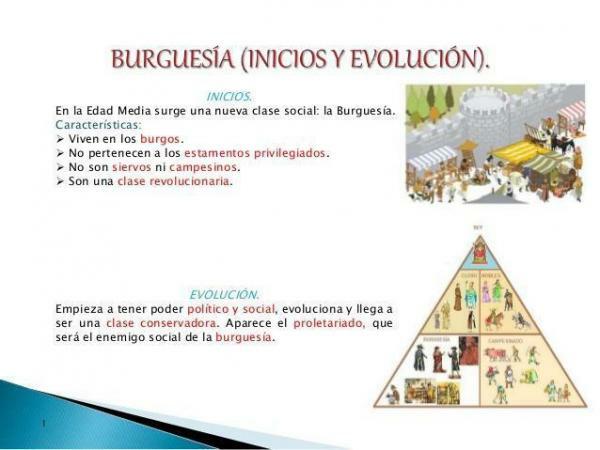High and Low Middle Ages - Differences

Image: Slideshare
The Middle Ages encompasses one of the longest periods in history as it comprises from the 5th century to the 15th century, that is, since the fall of the Roman Empire took place in the year 476 AD. C. until the middle of the 15th century when Constantinople was conquered by the Turks in 1453, which meant the fall of the Eastern Roman Empire.
Next, in this lesson from a TEACHER, we are going to see roughly the differences between the High and Low Middle Ages, the two great periods in which the Middle Ages was divided. While the High Middle Ages spans from the 5th to the 11th century, the Low Middle Ages from the 11th to the 15th century, therefore, the first of the differences that must be clear.
Index
- Political differences between the High and Low Middle Ages
- Economic differences between the High and Low Middle Ages
- Social differences between the High and Low Middle Ages
- Cultural differences between the High and Low Middle Ages
Political differences between the High and Low Middle Ages.
We begin by studying the differences between the High and Low Middle Ages talking about the political situation in both periods of history:
Politics in the High Middle Ages
In the High Middle Ages the power of the monarchy was in the hands of the nobility and high clergy, so the king had very little power.
Among the most outstanding events in the High Middle Ages we have to highlight the great wave of invaders (Germans and Berbers) that Europe suffered in the 11th century. In this other lesson from a TEACHER we will discover the Germanic invasions in Spain.
Political power in the late Middle Ages
In the late Middle Ages, little by little, the power of the kings was strengthened against the group of the nobility and the clergy, giving rise to great struggles between them. Over time, great and important monarchies were formed throughout Europe, Parliaments arose and the bourgeoisie often claimed the right of self-government through the fueros.
In the late Middle Ages we must highlight the invasions from the time of the Crusades, the Reconquest of the Iberian Peninsula and the Hundred Years War.

Economic differences between the High and Low Middle Ages.
Another difference between the High and Low Middle Ages lies in the economic situation of the two periods. While in the High Middle Ages the economic base was in the rural world, that is, in agriculture and subsistence livestock, in the production of home-made manufactures, so it was not possible to speak of trade, but rather of barter.
In the Middle Ages The economy was generally still mainly rural, however, little by little it began to take a development in cities becoming these in the new economic centers.
There was, in turn, an increase in both agricultural production and livestock, thanks, among other things, to the introduction of new cultivation techniques, and that in turn, led to a boom in trade, not only locally but also over a long distance, with the development of fairs and banking taking place. In this other lesson we will talk about the history and evolution of the currency.
Social differences between the High and Low Middle Ages.
In the High Middle Ages, the way a society was organized was Feudalism, based on the division of different classes among which were the privileged, who were the nobles and clergy, and the underprivileged, who were the peasants and artisans.
They differed between these two classes because the privileged had a series of privileges that the non-privileged did not. counted, for example, the fact that large areas of land were always in the hands of the group of privileged. Feudo-vassal relations were also very frequent.
In the Middle Ages feudalism continued to be given as a form of organization, although the appearance of the bourgeoisie as a new state that was part of the group of the underprivileged.
With regard to vassal relations, they continued to exist, although to a lesser extent. The fact that there was a boom in trade caused a great population growth.

Cultural differences between the High and Low Middle Ages.
And we will finish this lesson on the differences between the High and Low Middle Ages talking about the cultural sphere.
Sociocultural characteristics in the High Middle Ages
With regard to religion in the High Middle Ages in the Al-Andalus area it was Islam while Christianity occurred in the northern area.
As for culture, little by little the decline of the Greco-Roman culture of the early years began and it was only preserved thanks to the important role of the monasteries; the predominant languages were the vernacular and Latin.
As for art, the predominant style was Romanesque.
Sociocultural characteristics in the late Middle Ages
In the late Middle Ages the Christian kingdoms were gradually occupying the Muslim territories imposing their religion. There was a greater interest in education, so much so that the first universities emerged like the new training centers.
Vernacular languages began to be written and as regards the artistic field, the predominant style was Gothic.

Image: Slideshare
If you want to read more articles similar to High and Low Middle Ages - Differences, we recommend that you enter our category of Story.

![7 antecedents of the CHACO WAR- [SUMMARY + VIDEO !!]](/f/295b8f1ca54bc11f2cce6c11c1d06fb5.jpg?width=300&height=200)

